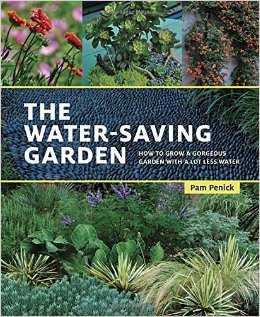The Water-Saving Garden [A Review]
When my wife and I got married, we thought we'd try our hand at gardening-the fruits of our labor that summer were pitiful, but the joy of growing our own food carried us on. It's a wonderful feeling to grow so much food for free, but the thing is that when you sit down and do the math, it's not that free anymore. After the cost of seeds, good soil, fertilizer, and most importantly, water, it can end up being fairly expensive. If you don't get a good yield from your plants, it can actually be more expensive than just buying groceries from the store.

Because of these concerns, I was intrigued to pick up a copy of The Water-Saving Garden by Pam Penick. If I could learn ways to make a gallon of water go further in my garden, I would love to. While Penick offers plenty of advice on how to be more thrifty in terms of water usage, unfortunately most of her advice wasn't very applicable to those who are trying to simply grow a small sustenance garden. I'll offer a fuller critique in a moment, but first, what I appreciated about the book.
The Water-Saving Garden is divided up into 5 parts: motivation and inspiration for a water-saving garden, practical strategies and habits to use less water in the first place, how to landscape and pick more drought-resistant plants, how to evoke the illusion of water abundance, and a list of specific water-saving plants to consider.
Parts two and three were probably the most helpful bits; she gets very practical about how to collect and use (free) rainwater as well as the importance of permeable paving that lets rainwater soak into the ground, as well as mulching that slows the evaporation of that same water. Further, she also helps the reader understand that lawns gently sloping away from the house are good for the house's foundation, but bad for water utilization because so much of what you sprinkle runs directly into the street. To that end, she gives practical ideas about how to replace lawns (which need tons of water in the first place) and re-landscape with native plants that are less thirsty and can trap water from running into the gutter.
Rainwater collection is a legitimately good idea that would help with my vegetable garden, except for the fact that I live in Colorado where it is very illegal to do so. I am very interested in trying some of her ideas with my front lawn, however, which is currently the epitome of water wastefulness. That's a lot of money that I don't need to be sending down the street! It was also valuable for me to think through the role of mulch in trapping water from evaporating, but I wish she would've spoken explicitly about vegetables (especially root vegetables) where you have to disturb the soil more frequently.
I hate to say it, but in general the book struck me as having a fairly pretentious tone. The introduction is mostly a guilt trip about using so much water in our country, and names sustainable living and climate change as the primary reasons anyone would want to save water. The pictures of gardens she presents in part one are these grand, sweeping vistas of beautiful shrubbery and carefully landscaped paths. I think gardens are beautiful as much as the next person, but it just seems like she's writing exclusively to upper class middle-aged Americans who garden because they can and because they don't have much else to do. Saving water, for this demographic, is mainly a moral concern rather than a financial one. I'm not in any way saying that these people shouldn't save water, but only that it comes across as very pretentious to those who need to save water in order to make gardening a feasible endeavor.
For what it is, the book is a good one, which is to say that it accomplishes what it intends. That being said, it wasn't the book I was hoping for. If you tend a largely non-edible garden, this will probably be a great read for you. You can pick up a paper copy of the book from Amazon for $13.
DISCLAIMER: I received a copy of this book from the publisher for the purpose of a fair, unbiased review.